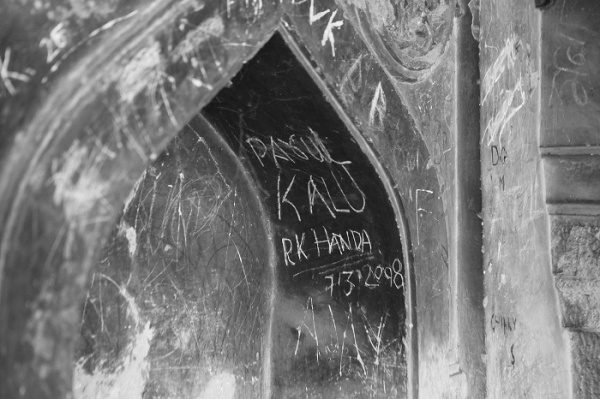Rampant vandalism disfigures trees, monuments, buses, etc. It seems to have become a way of life, anguishes Ruchira. A Different Truths exclusive.
 All of us who live in India are familiar with this phenomenon. We see it around us, everywhere, daily. In fact, so habituated are we that we do not spare a thought about the spectacle before our eyes. Rather we shake it off our minds and walk away as if nothing’s happened. You’ve guessed it right, it is the syndrome of vandalism, which I’m talking about.
All of us who live in India are familiar with this phenomenon. We see it around us, everywhere, daily. In fact, so habituated are we that we do not spare a thought about the spectacle before our eyes. Rather we shake it off our minds and walk away as if nothing’s happened. You’ve guessed it right, it is the syndrome of vandalism, which I’m talking about.
Look at the sprawling shady trees in any urban neighbourhood. You will invariably find words and phrases like ‘Jai Mata Di, 13 Mera 7’, ‘Bunty loves Pinky’ and such like stuff etched at various points across the bark. Seated on a park bench you are likely to notice the paint scrapped off at places. Often you might find the benches wobbly – the reason being one or two of its legs have been ripped off the ground where they were fixed.
Seated on a park bench you are likely to notice the paint scrapped off at places.
During the Commonwealth Games hosted in New Delhi, in 2010, the metropolis saw a spurt in ultramodern sophisticated bus stoppages. Made you feel as you had been transported to a phoren city! So far so good.
Less than ten years later, most of these are in ruins. The laminated polyvinyl posters, which formed the backdrop are torn apart, crisscrossed with scratches and lashes. The lighting arrangement defunct and so on…
The 1980’s was the era of “Whiteline buses” meant for comfortable, albeit costly travel within the city. Ahem… five years or so down the line, the pretty window curtains were purloined, window panes which had sporadic projectiles hurled at them, assumed cobweb-like designs, lights in the aisles smashed, fans over rows of seats had the wires wrenched off from the switches; foam stuffing pulled out of the seats and their backs engraved with unprintables!
One must admire the immense stamina and brainwaves of this category of passengers. By the way exposing the upholstery and writing on backs of seats were commonplace in the ordinary (now defunct) redline and blueline buses too. Wonder what pleasure can be derived from such mindless deeds?
The Delhi Metro too was a victim of vandalism, initially. The windows acquired the same cobweb designs courtesy stone-pesters, scratches appeared on seats and partitions in coaches.
The Delhi Metro too was a victim of vandalism, initially. The windows acquired the same cobweb designs courtesy stone-pesters, scratches appeared on seats and partitions in coaches. These acts have since taken a backseat. Instead, now, you find scores of unruly kids of all ages, using the dangling handle bars (meant for  standing commuters) for diverse acrobatic feats. They swirl, jump up and down, or occasionally swing to the next bar (if the carriage is less crowded). Owing to such barbaric onslaughts several handles had disappeared – leaving thin plastic wires behind. It is disgusting to see the parents beaming in delight at their wards’ (mis)deeds rather than admonishing them. So much for the future of our Bharat Mahan!
standing commuters) for diverse acrobatic feats. They swirl, jump up and down, or occasionally swing to the next bar (if the carriage is less crowded). Owing to such barbaric onslaughts several handles had disappeared – leaving thin plastic wires behind. It is disgusting to see the parents beaming in delight at their wards’ (mis)deeds rather than admonishing them. So much for the future of our Bharat Mahan!
Closer home in our own housing society, the hyper-activism of the youngsters often results in corridor lights being tampered with plunging the area into darkness; random fiddling with the floor buttons in the elevator lead to their malfunctioning, as a result of which the residents of the upper floors face great inconvenience.
Forget ephemeral issues, even timeless wonders and monuments seldom escape vandalising. Consider the wondrous Taj Mahal – India’ crowning glory, flagship of tourism. If you look closely you will find that the timeless marble edifice has obscene phrases, lovers’ names, weird designs and shapes, writ large on the outer walls. I am sure emperor Shahjahan as well as his beloved Begum might be writhing in their graves, witnessing the sad plight of their love memorial!
In Delhi, historical edifices from Red Fort to Qutub Minar have withstood ravages of time but not the atrocities inflicted by visitors who throng there.
In Delhi, historical edifices from Red Fort to Qutub Minar have withstood ravages of time but not the atrocities inflicted by visitors who throng there. The same idiotic thoughts, hackneyed motifs are there for you to see.
The last time I was in Kolkata, we happened to visit the Dakshineshwar temple complex. In one of the dozen Shiva shrines lining the precincts, we noticed a couple of college girls inscribing nonsensical stuff on the wall, feeling as pleased as Punch. My husband chided them for their misconduct. Those shameless girls smirked, muttered something under breath and ran away. What a way to preserve our rich cultural heritage!
Scores of other examples come to mind. During two consecutive visits to Kanyakumari I stumbled across many instances of vandalism. The mega boulders dotting the beach had love messages, phrases and signs scrawled all over them – the characteristic bleeding heart pierced by Cupid’s arrow, intact heart, lovers’ names, cities and year of love – everything was visible.
Possibly lovers consider it as a convenient and economical way to proclaim their emotions before the earth and sky and freeze it in time.
I had a similar experience in Manali. We ambled far below the picturesque Club  House, down to the rocky bank where river Beas rolls its waters; here too boulders and rocks carried snippets of tales of human love. Possibly lovers (or honeymooners perhaps?) consider it as a convenient and economical way to proclaim their emotions before the earth and sky and freeze it in time. Who knows?
House, down to the rocky bank where river Beas rolls its waters; here too boulders and rocks carried snippets of tales of human love. Possibly lovers (or honeymooners perhaps?) consider it as a convenient and economical way to proclaim their emotions before the earth and sky and freeze it in time. Who knows?
I have had the good fortune of travelling to a few cities outside India. I noticed graffiti at a few places; however compulsive, habitual vandalism is not quite visible. One does read about vandalism in some areas of Europe – a glaring example of which is the disfigured statue of the (Hans Andersen’s) famous Mermaid in Copenhagen, Danemark. Churches, offices and businesses do bear the brunt of public fury from time to time. But in India it is a different ball game altogether.
The change must be inculcated from within. Law and administration can do preci (Hans Andersen’sous little. When, oh when, will the Indians (save the sophisticated, civilised strata) learn to respect and preserve public as well as private properties and safeguard our rich, varied heritage? The clock is ticking away…
©Ruchira Adhikari Ghosh
Photos from the Internet






 By
By
 By
By
 By
By
It is a mystery to me. People are still captivated by the mesmerising beauty of the monument. Thank you for sharing.
Best regards